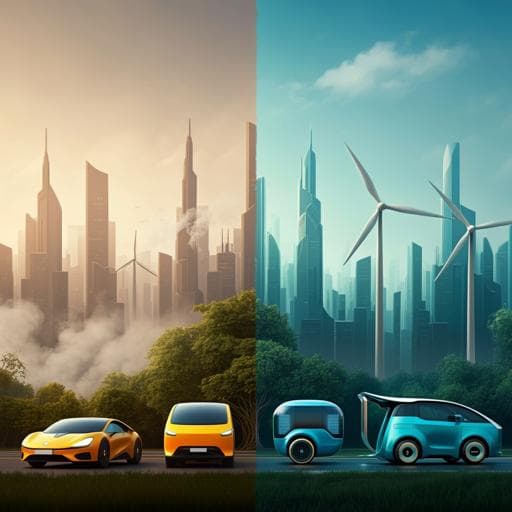
Environmental Studies and Forestry
Promoting economic and environmental resilience in the post-COVID-19 era through the city and regional on-road fuel sustainability development
C. Yang, H. Wu, et al.
This groundbreaking study by Chuxiao Yang, Haitao Wu, Yunxia Guo, Yu Hao, and Zhaohua Wang explores the economic and environmental resilience outcomes of phasing out fossil fuel vehicles. It not only highlights the significant reduction of CO2 and SO2 emissions but also examines the broader impacts of climate policies amidst fuel shortages and health concerns.
~3 min • Beginner • English
Introduction
The study addresses how to align post-COVID-19 transport policies with the 1.5 °C goal by transforming the on-road fuel mix and phasing out fossil fuel vehicles (FFVs). Given transport’s ~23% share of global energy-related CO2 emissions (with road transport ~72% of transport emissions), and China’s ~10% national CO2 share from transport, the paper examines whether banning FFV sales and promoting new energy vehicles (NEVs) can curb emissions while safeguarding economic recovery. It highlights the rebound risk of transport-related CO2 after COVID-19, China’s high oil import dependence (>70% in recent years), and urban air-quality and health impacts from SO2. The research questions are: (1) How will shifts in transport modes and vehicle powertrains affect energy use and emissions across cities/regions? (2) What macroeconomic and resilience effects arise from different climate policy instruments (intensity targets, caps, taxes) under shocks? (3) Beyond CO2 reduction, what other forces (energy security, local SO2 pollution) drive FFV phase-out? The study’s purpose is to provide evidence-based design of phased, regionally differentiated policies to enhance economic and environmental resilience.
Literature Review
The paper situates its inquiry within literature on transport decarbonization and policy mixes (e.g., bans on conventional vehicles, EV adoption, and personal carbon trading), post-COVID-19 transport demand declines and rebound risks, and regional economic resilience. Prior work discusses integrated policy mixes for deep CO2 mitigation in road transport; public support and design of car bans; EV penetration impacts; and resilience of cities and firms post-COVID-19. Gaps identified include limited urban/provincial-level analyses of transport emissions heterogeneity in China and insufficient evaluation of SO2-related local health impacts and energy security as drivers of FFV phase-out, alongside macroeconomic assessments under uncertainty.
Methodology
Data and scope: Panel data for 30 Chinese provinces/municipalities (2003–2019) from CEADs energy inventories; Chinese Statistical Yearbooks; BP Statistical Review (2020) for global oil trade; IEA World Energy Balances; national road mileage datasets (US DOT, India MoRTH). Analyses proceed at city/province and international comparative scales.
1) Markov-chain forecasting: A homogeneous Markov-chain models transitions in shares of transport modes (rail, road, waterway, civil aviation) and vehicle powertrains (FFVs, BEVs, PHEVs, FCVs). Historical state vectors (2011–2019) yield one-step transition probability matrices; average transition matrices are used to project shares through 2060. The model also forecasts import share competition among major oil importers (China, US, EU, India, Japan) to capture market share dynamics under a fixed-sum constraint.
2) Emissions intensity metrics: Carbon emission intensity (CEI) of road transport computed as CO2 emissions over (a) total GDP and (b) transportation sector added value (TSOV). CO2 emissions for transport are estimated using energy consumption by fuel type multiplied by fuel-specific emission factors. SO2 emissions are calculated from sulfur content and fuel use. For urban comparisons, SO2 intensity is computed per roadway kilometer and per unit land area, arguing these denominators better capture on-road pollution exposure than per capita.
3) DSGE framework and static comparisons: A Robinson–Crusoe economy with Cobb–Douglas production Y = Z K^α M^γ H^(1−α−γ), where M proxies polluting intermediates (including road transport emissions). The planner maximizes U = ln C + η ln(1−H) subject to resource and emissions constraints. First-order conditions derive steady states under four policy scenarios, each applied separately: (i) No policy (benchmark), (ii) Emission intensity target (µ), (iii) Emission cap (M fixed), and (iv) Emission (energy) tax (τ), with revenue rebated lump-sum. Analytical expressions show how shares of consumption, capital, labor, and emissions respond to policy and productivity.
4) Stochastic shocks and resilience: A DSGE variant replaces M with energy use E, mapping to CO2 and SO2 via scaling parameters and on-road shares. Energy price follows AR(1), and impulse responses compare business-as-usual (BAU) vs energy tax (ET) to assess smoothing of fluctuations and resilience.
Calibration: Parameters are chosen to reflect China’s economy drawing from the literature; details are provided in supplementary material.
International comparisons: Cross-country visualization of road transport CO2 vs GDP (China, US, EU, Japan, India) and SO2 vs roadway mileage (China, US, Japan, India) contextualizes China’s trajectory.
Key Findings
- Transport mode shifts: Markov forecasts indicate a post-COVID-19 decrease in road transport rotation volumes for passengers and freight, with a compensating rise in rail, reflecting both behavioral changes and policy direction (14th Five-Year Plan).
- Vehicle powertrain transition: Predicted FFV shares decline to ~87% (2030) and ~66% (2060); corresponding reductions relative to 2020 sales are ~8.09% and ~31.53%. NEV shares rise steadily, led by BEVs and PHEVs; FCVs remain negligible through 2060.
- Energy security driver: Markov-based competition modeling suggests China’s share of global oil imports could reach ~42.7% by 2030 absent constraints—unlikely to be met due to geopolitical risks and supply limits—creating a strong internal driver to phase out FFVs.
- Regional heterogeneity in CO2 intensity: Using GDP as denominator (2003–2019), highest road transport CEI averages are in Yunnan, Xinjiang, and Guangxi; lowest in Hebei, Beijing, and Shanghai. Using transportation sector GDP, highest CEI averages are in Yunnan, Inner Mongolia, and Ningxia, indicating lower transport sector economic efficiency and higher energy needs per unit output in sparsely populated regions.
- Urban SO2 intensity and health driver: SO2 per capita intensities rose across provinces between 2004 and 2019, with more provinces exceeding higher thresholds by 2019. SO2 intensity per roadway km and per unit area in major cities shows Shanghai and Guangzhou as highest among sampled cities, with limited change over time, highlighting persistent exposure risks in dense urban cores. SO2 impacts and TWC converter poisoning underscore local air-quality/health as a second major driver for FFV phase-out beyond CO2.
- Macroeconomic policy comparisons: In deterministic steady state, emission cap and emission tax are equivalent; all climate policies dampen output relative to BAU. Under energy tax (with shocks), total energy and road transport energy fluctuate less than under BAU, indicating enhanced economic resilience (smoothing of exogenous energy price shocks) via reduced energy intensity.
- International context: The US has the highest road transport CO2 and SO2 emissions; China’s road transport CO2 surpassed the EU around 2015; India shows the fastest CO2 growth rate, followed by China. China exhibits the fastest growth in road-transport-related SO2 with roadway expansion; the US shows declines; Japan’s roadway length is flat but SO2 still trends upward.
- Policy impact magnitudes (stated): Phasing out FFVs and banning their sale can reduce energy consumption by about 10% of total energy, cut CO2 by ~1 billion tons, reduce SO2 in central urban areas by ~3000 tons, and alleviate oil supply-demand for road transport by ~400–600 million tons.
Discussion
The findings support phasing out FFVs as a dual-benefit strategy addressing global climate goals (CO2 reduction) and local urban air quality (SO2 reduction), while mitigating energy security risks from rising oil import dependence. Markov forecasts and regional CEI/SO2 analyses reveal heterogeneity across Chinese provinces and major cities, implying that uniform, nationwide policies could have uneven impacts; regionalized approaches are warranted. DSGE-based comparisons show that while climate policies can slightly dampen steady-state growth, instruments like an energy tax can buffer the economy against energy price shocks, thereby strengthening economic resilience. International benchmarks indicate that without proactive transition, China’s transport emissions will continue to rise rapidly with economic growth and vehicle ownership, reinforcing the urgency of early, well-designed interventions including NEV promotion and infrastructure build-out.
Conclusion
The paper integrates Markov-chain forecasting with a DSGE policy assessment to show that transitioning away from FFVs toward NEVs can materially reduce CO2 and SO2 emissions, enhance urban environmental quality, and improve economic resilience by lowering exposure to energy price shocks and external oil supply risks. It identifies two additional core drivers for FFV phase-out beyond CO2: urban SO2 health impacts and energy security. Policy implications include adopting phased, differentiated, region-specific measures; prioritizing NEV infrastructure (e.g., charging networks); and considering energy/emissions taxes to smooth shocks. Future research should refine city-level exposure metrics, incorporate broader uncertainties (e.g., technological breakthroughs, behavioral shifts), assess distributional impacts and costs, and evaluate integrated policy mixes (e.g., combining bans, taxes, and trading with infrastructure investments) over longer horizons.
Limitations
- Data scope constraints limit analysis to 30 provinces/municipalities due to accessibility, potentially omitting finer-grained urban heterogeneity.
- SO2 intensity lacks universally accepted transport-specific denominators; the study proposes per road km and per area, which, while rationalized, may still simplify exposure patterns.
- Markov-chain forecasts assume relative stability in transition probabilities and no major structural breaks; results may be sensitive to unforeseen technological or policy shocks.
- Global oil import share projections assume no major changes in total exports and steady economic growth; geopolitical and supply disruptions could alter outcomes.
- DSGE analysis compares single-instrument scenarios and, in deterministic steady state, equates cap and tax; real-world policy mixes and uncertainty may yield different dynamics.
- Parameter calibration tailored to China may limit generalizability; costs of policies and infrastructure (e.g., charging) are not fully quantified.
Related Publications
Explore these studies to deepen your understanding of the subject.







